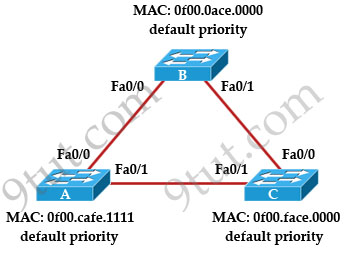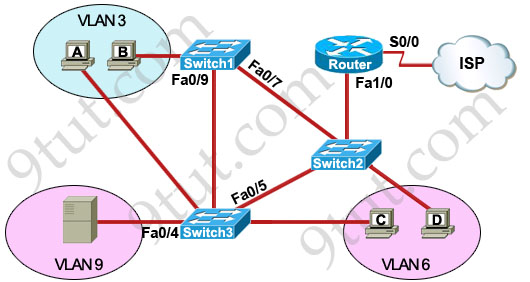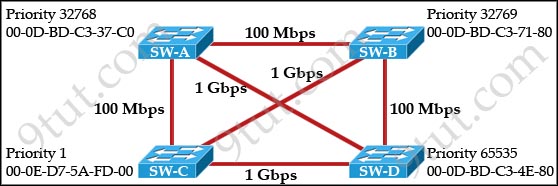New CCNA – STP
Note: If you are not sure about Spanning Tree Protocol, please read our Spanning Tree Protocol STP Tutorial (Premium Tutorial).
Question 1
Refer to the topology shown in the exhibit. Which ports will be STP designated ports if all the links are operating at the same bandwidth? (Choose three)

A. Switch A – Fa0/0
B. Switch A – Fa0/1
C. Switch B – Fa0/0
D. Switch B – Fa0/1
E. Switch C – Fa0/0
F. Switch C – Fa0/1
Answer: B C D
Explanation
First by comparing their MAC addresses we learn that switch B will be root bridge as it has lowest MAC. Therefore all of its ports are designated ports -> C & D are correct.
On the link between switch A & switch C there must have one designated port and one non-designated (blocked) port. We can figure out which port is designated port by comparing their MAC address again. A has lower MAC so Fa0/1 of switch A will be designated port while Fa0/1 of switch C will be blocked -> B is correct.
Question 2
What value is primarily used to determine which port becomes the root port on each non-root switch in a spanning-tree topology?
A. lowest port MAC address
B. port priority number and MAC address.
C. VTP revision number
D. highest port priority number.
E. path cost
Answer: E
Explanation
The path cost to the root bridge is the most important value to determine which port will become the root port on each non-root switch. In particular, the port with lowest cost to the root bridge will become root port (on non-root switch).
Question 3
What is one benefit of PVST+?
A. PVST+ reduces the CPU cycles for all the switches in the network.
B. PVST+ automatically selects the root bridge location, to provide optimization.
C. PVST+ allows the root switch location to be optimized per vlan.
D. PVST+ supports Layer 3 load balancing without loops.
Answer: C
Explanation
Per VLAN Spanning Tree (PVST) maintains a spanning tree instance for each VLAN configured in the network. It means a switch can be the root bridge of a VLAN while another switch can be the root bridge of other VLANs in a common topology. For example, Switch 1 can be the root bridge for Voice data while Switch 2 can be the root bridge for Video data. If designed correctly, it can optimize the network traffic.
Question 4
Which two protocols are used by bridges and/or switches to prevent loops in a layer 2 network? (Choose two)
A. 802.1d
B. VTP
C. 802.1q
D. STP
E. SAP
Answer: A D
Question 5
In which circumstance are multiple copies of the same unicast frame likely to be transmitted in a switched LAN?
A. after broken links are re-established
B. in an improperly implemented redundant topology
C. when upper-layer protocols require high reliability
D. during high traffic periods
E. when a dual ring topology is in use
Answer: B
Explanation
If we connect two switches via 2 or more links and do not enable STP on these switches then a loop (which creates multiple copies of the same unicast frame) will occur. It is an example of an improperly implemented redundant topology.
Question 6
Refer to the exhibit.

A problem with network connectivity has been observed. It is suspected that the cable connected to switch port Fa0/9 on Switch1 is disconnected. What would be an effect of this cable being disconnected?
A. Host B would not be able to access the server in VLAN9 until the cable is reconnected.
B. Communication between VLAN3 and the other VLANs would be disabled.
C. The transfer of files from Host B to the server in VLAN9 would be significantly slower.
D. For less than a minute, Host B would not be able to access the server in VLAN9. Then normal network function would resume.
Answer: D
Question 7
Which port state is introduced by Rapid-PVST?
A. learning
B. listening
C. discarding
D. forwarding
Answer: C
Explanation
PVST+ is based on IEEE802.1D Spanning Tree Protocol (STP). But PVST+ has only 3 port states (discarding, learning and forwarding) while STP has 5 port states (blocking, listening, learning, forwarding and disabled). So discarding is a new port state in PVST+.
Question 8
Refer to the exhibit. Based on the information given, which switch will be elected root bridge and why?

A. Switch A, because it has the lowest MAC address
B. Switch A, because it is the most centrally located switch
C. Switch B, because it has the highest MAC address
D. Switch C, because it is the most centrally located switch
E. Switch C, because it has the lowest priority
F. Switch D, because it has the highest priority
Answer: E
Question 9
Which term describes a spanning-tree network that has all switch ports in either the blocking or forwarding state?
A. redundant
B. spanned
C. provisioned
D. converged
Answer: D
Explanation
Spanning Tree Protocol convergence (Layer 2 convergence) happens when bridges and switches have transitioned to either the forwarding or blocking state. When layer 2 is converged, root bridge is elected and all port roles (Root, Designated and Non-Designated) in all switches are selected.
Question 10
Refer to the exhibit. Given the output shown from this Cisco Catalyst 2950, what is the most likely reason that interface FastEthernet 0/10 is not the root port for VLAN 2?
Switch# show spanning-tree interface fastethernet0/10

A. This switch has more than one interface connected to the root network segment in VLAN 2.
B. This switch is running RSTP while the elected designated switch is running 802.1d Spanning Tree.
C. This switch interface has a higher path cost to the root bridge than another in the topology.
D. This switch has a lower bridge ID for VLAN 2 than the elected designated switch.
Answer: C



Q1,5,6,7,9 yesterday. passed. tnx 9tut!
Hi, Peter. Where are you from ?
Q1, Q8 on 15th Feb.
Is E a correct answer in Q8? Priority can only be set in increment of 4096, so how can the priority be set to 1?
@Ed
Good question…from my study and internet research, bridge’s priority number must be in the increment of 4096. Can someone explains? Thanks.
the bridge priority is between 1 and 65535 so it starts with 1
Can anyone tell me about Q10. why the answer 1 is incorrect?
can anybody please explain q 10 answer??
Passed yesterday with score 1000 Thank God
The exam was 51 questions, only one drag and drop about cable types, all questions are very easy just similar to 9tut.
The lab simulations were Eigrp , ACL1 (similar to 9tut exactly) and ACL2 (modification 3 but with host B to access the finance server)
Good luck for everyone, just be relaxed its very very easy :)
question 8 was in it
in reponse to q10, I think the reason it is not answer a is because even if there was another interface within the vlan, it doesn’t explain why port fa0/10 is in alternate disabled mode. fa0/10 is disabled because it has a higher cost to the root bridge within that vlan.
Question 8 is BS you CANNOT set the priority to one the lowest is 0 and then 4096
AHCORESW(config)#spanning-tree vlan 10 pri
AHCORESW(config)#spanning-tree vlan 10 priority 1
% Bridge Priority must be in increments of 4096.
% Allowed values are:
0 4096 8192 12288 16384 20480 24576 28672
32768 36864 40960 45056 49152 53248 57344 61440
AHCORESW(config)#
Q8: Yes, however:
Bridge ID priority note as per cisco, 32769 (default bridge priority plus system ID extension of default VLAN1).
0 + 1 (vlan 1 by default) = priority of 1
Note priority is already “set” in CLI and accepted as such…….
please send me dumps
Cisco.Actualtests.200-120.CCNA.v2013-10-01.by.examtut.278q.vce Editor Choice
AT Email – monzer322@yahoo.com
Passed my CCNA exam today (18th Mar)… Q2, Q4 and Q8 in exam
I have new vce dumps but dont have vce player latest version
Question 10 is Arguable…..
^ You know nothing John Doe
passed with 988/1000. read todd lammle book do lab practices and revise 9tut questions. you will pass most of the questions are from this site
hi guys, am currently studying for my CCNA and your comments have highly motivated me.
Sunil, could you share vce dumps, thanks in advance siaulietisss@yahoo.com
Please explain question no 6
Q4,6,8,9
to Amit Upadhyay:
When the link fails, STP will be recalculated in order to find alternate and loopfree path. This time is usually les than 1 min. With rapid STP the time is even lower.
Can anyone please help me with the last version of the VCE Simulator? I can´t open many VCE files with the version that I have. Please my e-mail is cliche0025@gmail.com. Thanks.
Q1 when we selecting Designate port,what is the correct logic?
I know all the ports in root bridge (excluding RP)are designated ports.
But we select a DP on a network segment (link) what is the sequence we need to consider?
as a example lets say terms of cost is equal to both A and C ports then what we need to check next..
1st.terms of cost
2nd. interface ID(number)
3rd. bridge id
4th. MAC address
is this sequence is correct???
Hi Nadith,
the correct sequence is :
1- Cost to root bridge.
2- Lost Bridge ID ( Bridge priority + MAC address)
3- Lowest Interface number.
Thank you ,Beel!!
-to select a designated port , at first we must find the lowest bridge ID ( priority and then MAC @), not the cost to root bridge.
-to select a root port we need to choose the lowest cost to root bridge, but if it’s the same, we check the bridge ID (that’s why it saids the links are operating at the same bandwidth).
Can anyone share with me recent dump in this address shohanachowdhury007@gmail.com
Thanks god I passed my exam today with 980/1000 the exam was very easy, but you should focus on the questions.
My advice to pass the exams is to answer the question fast, but make sure you choose the right answer before you move to the next one; also, the important thing to pass the exam is don’t be nervous relax my friend, and think about the succeeding only and you are good to go.
peace ^_^
Q6. I see a device in Vlan3 trying to communicate with a device in Vlan9…wouldn’t this traffic have to pass through a router, thus making Fa0/9 irrelevant in this scenario?
Maybe I’m missing something here, please enlighten me.
I Need help for ccna exam. Could anyone please send me dumps at golf1214@yahoo.com Thank you for your time!
Passed with 972/1000 thanx to 9tut and Watson
TMayedzenga,
Would you post the questions you remember please? Thanks